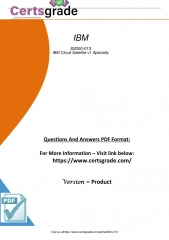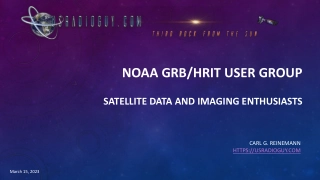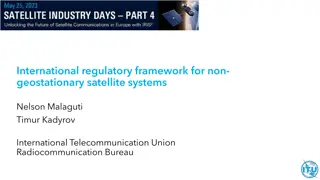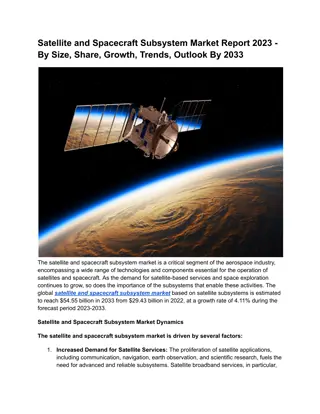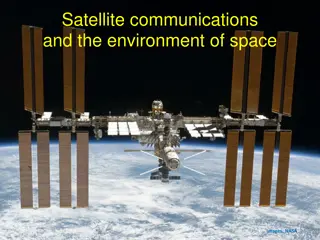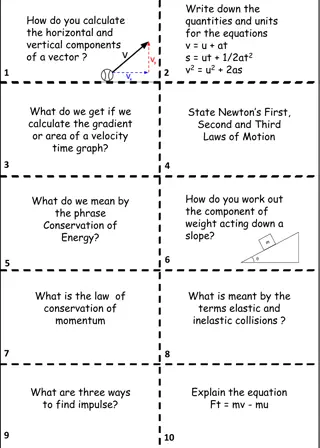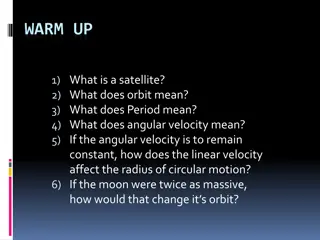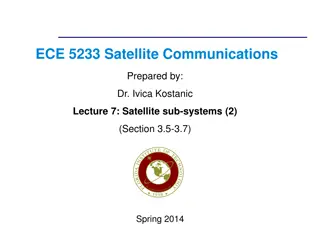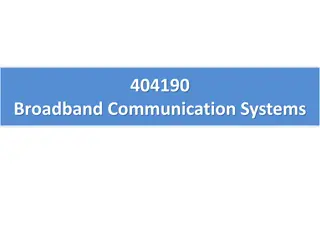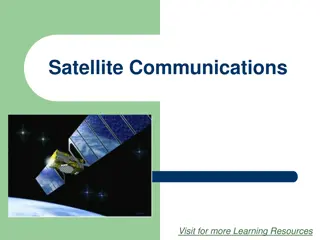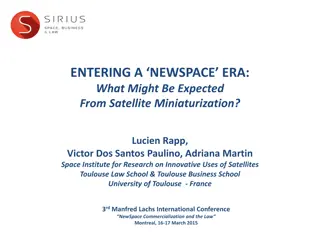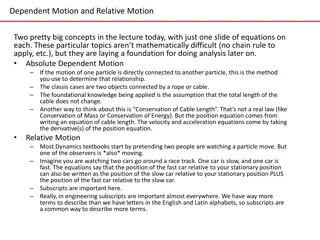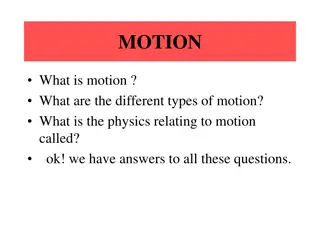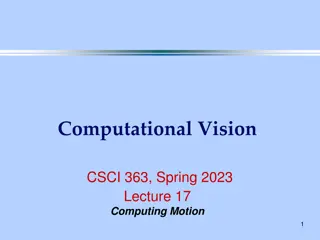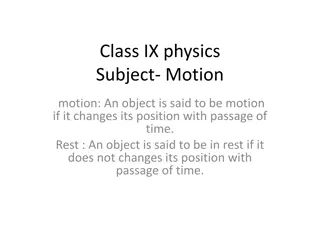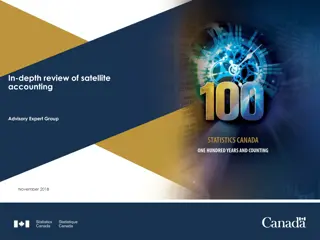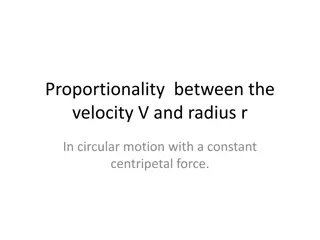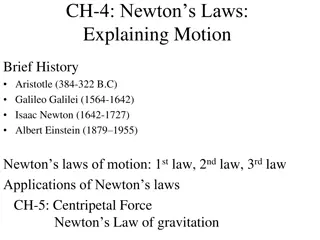Satellites and Orbits
The realm of satellites and orbits, covering topics such as Kepler's Laws, meteorological satellite orbits, the history of satellite remote sensing, and different types of orbits including geostationary and sun-synchronous orbits. Explore the significance of inclination angles, orbital speeds, and d
3 views • 22 slides
Maximize Success S2000-013 IBM Cloud Satellite v1 Specialty Mastery
Elevate your career with success in the S2000-013 exam. Master the IBM Cloud Satellite v1 Specialty with comprehensive study materials, practice tests, and expert guidance. Prepare effectively for the IBM Cloud Satellite v1 Specialty exam and gain the skills and knowledge necessary to excel in cloud
1 views • 6 slides
Resources for Satellite Data and Imaging Enthusiasts
Explore a plethora of guides, builds, and software tools tailored for satellite data and imaging enthusiasts. Discover user groups, forums, and decoding solutions to enhance your experience in working with signals and files from GOES satellites. Vitality GOES offers a new way to access and interpret
0 views • 9 slides
Challenges and Opportunities in Satellite Connectivity Systems
Satellite connectivity systems face challenges such as handset emissions, limited bandwidth, and interference issues, but also present opportunities for innovative technologies like high-gain systems and phased array antennas. The European Union's MSS S-band spectrum allocation in 2009 is a notable
0 views • 10 slides
International Regulatory Framework for Non-Geostationary Satellite Systems
Understanding the international regulatory framework for non-geostationary satellite systems, including coordination for protection of existing services, spectrum access/use laws, satellite frequencies and services, and mechanisms for protecting geostationary satellite orbits. The regulations aim to
2 views • 17 slides
Satellite Communications Support for Enhanced Emergency Communications
Providing support for enhanced emergency communications through mobile and fly-away satellite systems. These systems offer cellular-based WiFi, satellite-based WiFi, and voice over IP phone numbers for use during communication disruptions. Satellite airtime is provided at no cost to TxDOT through th
2 views • 4 slides
Satellite and Spacecraft Subsystem Market Size, Share, Growth, Trends, Outlook By 2033
The global satellite and spacecraft subsystem market based on satellite subsystem is estimated to reach $54.55 billion in 2033 from $29.43 billion in 2022, at a growth rate of 4.11% during the forecast period 2023-2033.\nRead Report Overview: \/\/bisresearch.com\/industry-report\/satellite-spacecraf
1 views • 3 slides
Understanding Projectile Motion: Characteristics, Examples, and Formulas
Projectile motion involves the motion of objects under the influence of gravity, with both vertical and horizontal components. This type of motion is seen in activities such as throwing a ball, kicking a football, or dropping objects. The motion is described by specific formulas, including calculati
1 views • 19 slides
Understanding Newton's First Law of Inertia
Newton's first law of inertia states that objects remain at rest or in uniform motion unless acted upon by an external force. This law, also known as the law of inertia, explains how objects tend to maintain their current state of motion unless influenced by an external force. Objects at rest stay a
0 views • 14 slides
Understanding Motion: Frames of Reference and Relative Motion
Motion is defined as a change in position over time. To describe motion accurately, one needs to understand frames of reference and relative motion. Frames of reference are systems of objects used to determine if something is in motion, while relative motion involves movement in relation to a refere
3 views • 14 slides
Understanding Motion: Concepts and Definitions in Physics
Motion in physics is defined as the change in position of an object over time. It involves concepts like rest, motion, distance, displacement, rate of motion, and types of motion. Rest and motion are relative to a reference point, while distance and displacement differ in their scalar and vector nat
2 views • 25 slides
Understanding Linear and Rotational Motion in Physics
Explore the concepts of linear momentum, center of mass, rotational motion, and angular displacement in physics. Learn how to determine the center of mass of objects, analyze motion of particle groups, and understand the conservation of momentum in systems under external forces. Delve into the funda
0 views • 18 slides
Understanding Circular Motion in Physics
Circular motion involves objects moving in a circular path at a constant speed, experiencing acceleration and centripetal force. This motion is characterized by angular speed, centripetal acceleration, and the necessary centripetal force. The concept of uniform circular motion and angular displaceme
3 views • 38 slides
Understanding Newton's First Law of Motion
Exploring the foundational concepts of motion and forces, this content delves into Isaac Newton's First Law of Motion. Describing how objects behave when the net force acting on them is zero, the law highlights the significance of inertia and balanced forces in determining an object's state of rest
0 views • 9 slides
Exploring Satellite Orbits and Space Missions
This content covers a variety of topics related to satellites, including geosynchronous orbit, satellite history, organisms sent to orbit, types of orbits, orbital altitudes, and current satellite usage. It delves into the history of satellite launches, types of orbits, and the functions of satellit
0 views • 20 slides
Investigating FUNcube Satellite and Space Environment
FUNcube satellite, a small satellite equipped with solar panels, batteries, and communication antennas, operates above Earth's atmosphere to collect and relay data through radio communication. By analyzing the telemetry graphs produced by the satellite, tasks include determining the time taken for o
0 views • 9 slides
Principles of Satellite Communications in Engineering
Explore the history and fundamentals of satellite communications, including the evolution from the first artificial satellite, Sputnik, to modern active and passive satellite systems. Learn about communication via satellites as microwave repeater stations, bridging distances and optimizing frequenci
0 views • 13 slides
Understanding Vertical Motion and Gravity in Kinematics
Explore the principles of vertical motion and gravity in kinematics through scenarios involving throwing objects, free-fall motion, and calculating heights. Learn how to model vertical motion with acceleration due to gravity, find maximum heights of thrown objects, solve extended problems, and under
2 views • 12 slides
Development of Satellite Passive Microwave Snowfall Detection Algorithm
This study focuses on the development of a satellite passive microwave snowfall detection algorithm, highlighting the challenges in accurately determining snowfall using satellite instruments. The algorithm uses data from AMSU/MHS, ATMS, and SSMIS sensors to generate snowfall rate estimates, overcom
0 views • 20 slides
Understanding Newton's Laws of Motion
Explore the fundamental concepts of Newton's Laws of Motion, including net forces, combining forces, balanced versus unbalanced forces, and the concept of inertia. Learn how these principles explain the behavior of objects in motion and at rest, and discover the impact of mass on an object's resista
0 views • 17 slides
Physics Concepts and Laws Explained
Quantities and units in physics equations, calculation of vector components, laws of motion, conservation of energy, conservation of momentum, impulse, elastic and inelastic collisions, gravitational potential energy, projectile motion, satellite motion, special relativity postulates, time dilation
0 views • 10 slides
Understanding Joint Motion: Osteokinematic and Arthrokinematic Movements
Joint motion involves osteokinematic movements, which are under voluntary control and include flexion, extension, and more. End-feel sensations like bony, capsular, and springy block indicate different joint conditions. Arthrokinematic motion refers to how joint surfaces move during osteokinematic m
0 views • 17 slides
Understanding Satellite Orbits and Motion
Explore the concepts of satellites, orbits, period, and angular velocity in relation to circular motion. Learn how these factors affect the motion of objects in space and understand the relationship between linear and angular velocity. Discover the impact of mass on an object's orbit and how it infl
0 views • 7 slides
Understanding Newton's Laws of Motion
Newton's Laws of Motion explain the relationship between forces and motion. The first law states that an object in motion stays in motion unless acted upon by a net force, while the second law describes how force is related to an object's mass and acceleration. The third law states that for every ac
0 views • 21 slides
Overview of Satellite Communication Sub-systems in ECE 5233: Satellite Communications
This content provides insights into satellite communication sub-systems such as transponders, antenna systems, and frequency plans. It covers topics like double conversion transponders, regenerative transponders, and examples of frequency allocation in satellite transponders. The detailed block diag
0 views • 10 slides
Satellite System Design Considerations and Applications
Satellite system design involves various technical considerations such as optimal modulation, coding schemes, and service types. Positioning satellites in orbit faces challenges like frequency and orbit selection. Satellite limitations include high initial investments and spectrum crowding. However,
0 views • 32 slides
Understanding Broadband Communication Systems and Satellite Communications
Broadband communication systems involve the use of satellites for various applications such as TV services, data services, and communication with ships and aircraft. This content delves into orbital mechanics, the gravitational forces in satellite orbits, as well as the orbital heights and velocitie
0 views • 57 slides
Understanding Satellite Communications and Its Advantages
Satellite communications play a crucial role in allowing two Earth stations to communicate through a relay satellite. This method offers various advantages such as extended coverage area, independent transmission cost, precise communication, and higher bandwidth availability. Despite its benefits, s
0 views • 20 slides
Understanding Newton's Laws of Motion
Newton's Laws of Motion describe how objects behave in response to external forces. The first law states that objects in motion remain in motion unless acted upon by a force, while objects at rest stay at rest. The second law relates force, mass, and acceleration, showing how they are interconnected
0 views • 11 slides
Understanding Motion and Newton's Laws
Explore the concepts of motion, distance, speed, and velocity as they relate to Newton's Laws of Motion. Learn about measuring motion, calculating speed, graphing motion on distance-time graphs, and understanding velocity. Discover how motion is constant and how relative motion is used. Practice cal
0 views • 36 slides
Understanding Motion and Newton's Laws
Motion is the constant change in position of objects, measured by distance and displacement. Speed is the rate of motion, while velocity includes direction. Graphing motion helps visualize speed changes over time. Newton's Laws explain the behavior of objects in motion.
0 views • 38 slides
Satellite Miniaturization Trends and Market Growth Analysis
The paper discusses the impact of satellite miniaturization on the space industry, showcasing new entrants in the market and the evolution of small satellite classes based on mass ranges. It highlights the transition from student projects to commercial services, emphasizing the advancements in techn
0 views • 18 slides
Understanding Dependent and Relative Motion in Dynamics
Dependent Motion and Relative Motion are fundamental concepts in Dynamics, providing the foundation for future analysis. Dependent Motion involves constraints like ropes or cables, while Relative Motion considers observers in motion. Dynamics involves applying a limited set of equations in diverse w
0 views • 18 slides
Understanding Motion: Types and Physics
Motion refers to a body changing position with respect to its surroundings. Different types of motion include linear, rotatory, and oscillatory motion. The physics relating to motion is called Mechanics, which comprises Dynamics and Kinematics. Scalars and vectors play a crucial role in describing t
0 views • 8 slides
High-Level Session on Public-Private Engagement for Sustainable Satellite Data Service
Explore the dynamic landscape of public-private collaboration in the space market at the Fifth High-Level Session of the Open Consultative Platform. Gain insights into strategies, policies, and collaboration models shared by space agencies and commercial satellite companies. Delve into key topics di
0 views • 6 slides
Understanding Motion Perception in Computational Vision
In computational vision, the concept of motion opponency plays a crucial role in how the brain processes left and right motion inputs. By examining psychophysical results and the construction of motion opponent energy filters, we explore how the brain handles motion information. Additionally, the Ve
0 views • 23 slides
Understanding Motion in Physics: Definitions and Examples
An object is said to be in motion if it changes position with time, while rest implies no change. Learn about types of motion such as linear and circular, as well as vibratory motion and reference points. Explore how objects can be in motion relative to one reference point while at rest relative to
0 views • 4 slides
In-Depth Review of Satellite Accounting Advisory Expert Group November 2018
Given the proliferation of satellite accounts, an in-depth review was conducted by the CES Bureau to determine the need for general guidance on priority areas and approaches in developing satellite accounts. The review led by Statistics Canada in collaboration with international organizations aims t
0 views • 19 slides
Understanding Orbital Motion and Circular Velocity in Physics
Explore the concept of orbital motion and circular velocity in physics, where we delve into the relationship between velocity and radius in circular motion with a constant centripetal force. Through Newton's 2nd Law and gravitational forces, we uncover the dependence of satellite speed on the radius
0 views • 13 slides
Evolution of Motion Theories: Aristotle to Einstein
Explore the progression of motion theories from Aristotle's belief in a force for motion to Galileo's discoveries on gravity, Newton's laws of motion, and Einstein's theories of relativity and quantum mechanics. Discover how our understanding of motion has evolved over the centuries, shaping the way
0 views • 20 slides

